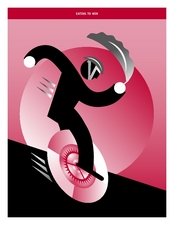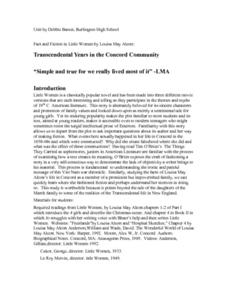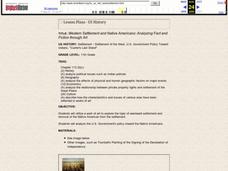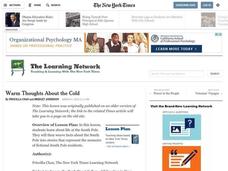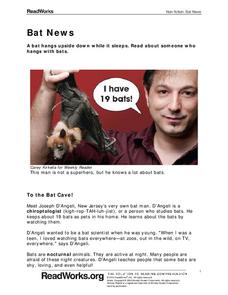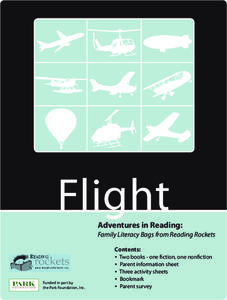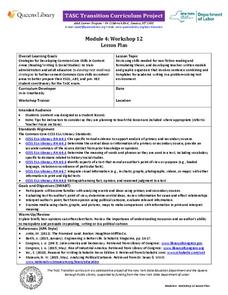Curated OER
Who Are We? An Introduction to the Life Within Our Bodies
Students examine cell structure, cell division, and the basic structure of DNA. They read and discuss a case study of DNA research, answer discussion questions, role-play the process of mitosis, and complete a DNA Fact or Fiction worksheet.
Curated OER
Civil War on Sunday
Third graders read "Cvil War on Sunday" together and discuss characters, setting, problem and resolution. They determine facts from fiction used in the story and research drummer boys in the Civil War or Clara Barton using the Internet....
Curated OER
Cook-A-Doodle Doo! Lesson Plan
Students enjoy the excitement in the short story, Cook-A-Doodle-Doo! In this Cook-A-Doodle Doo! lesson plan, students work to tell the difference between fact and fiction, learn vocabulary, and compare and contrast different stories.
Curated OER
Eating to Win
Young scholars examine human health by completing a sports nutrition worksheet. In this eating habits lesson, students discuss the importance of a balanced diet and proper feeding times when competing in physical activities. Young...
Curated OER
Fact and Fiction in Little Women
Students read excerpts from the novel "Little Women." Students work in groups to research, analyze, and answer the questions included in the lesson plan. After research, students write a paper and include a bibliography. The students...
Curated OER
Shark Encounter
Sixth graders identify fact and fiction about sharks. In this investigative lesson students graph results of a shark survey and label parts of a shark.
Curated OER
Into the World of Spook
Students explore the Web portal for the British Secret Service. In this current events lesson, students discover facts and fictional accounts about British spies as they listen to lectures and participate in classroom discussions.
Curated OER
Context Clues, Plot Structure, Conflict, and Personal Narrative Essay
What are the elements of a personal narrative? Get your class talking by reading "The Necklace" and "A Dangerous Game." The instructional activity focuses primarily on defining certain vocabulary terms (like context clues, plot,...
Curated OER
News real?
Students distinguish and evaluate information from various sources and determine whether the information found is fiction or facts. They also view television shows, radio stations and newspaper articles Internet sites are also visited by...
Curated OER
Western Settlement and Native Americans: Analyzing Fact and Fiction through Art
Eleventh graders utilize a work of art to explore the topic of westward settlement and removal of the Native American from the settlement. They analyze the U.S. Government's policy toward the Native Americans.
Administrative Office of the US Courts
Snyder v. Phelps
Does the Westboro Baptist Church have the protection of the Constitution when protesting military funerals? High schoolers examine the 2011 Supreme Court case of Snyder v. Phelps before comparing the situation to a fictional...
Curated OER
The News Behind the Story
What a fun way to analyze plot, setting, and character. Learners review story elements, read a short fictional story, then turn the events of that story into a headlining news paper article. Not only does this lesson engage critical...
Curated OER
Warm Thoughts About the Cold
“What do you think life is like at the South Pole?” After responding to this journal prompt, class members read and discuss the New York Times article, “At South Pole, New Home for a New Era.” Using resources available from the Times’...
Read Works
Bat News
Get the bat facts with a short nonfiction reading passage. After reading the passage, readers respond to questions that focus on main idea, inferencing, vocabulary in context, and author's purpose.
Novelinks
The Cure: Concept Vocabulary Analysis
Considering a study of science fiction, speculative fiction, and/or dystopian fiction? Check out this concept analysis of Sonia Levitin's The Cure. The guide provides enough information to let you know if her novel would fit your...
PBS
Reading Adventure Pack: Flight
A Reading Adventure pack focuses on the invention of flight. After reading a fiction and nonfiction book, scholars take their newfound knowledge to design a one-passenger flying device, experiment with different types of paper airplanes...
EngageNY
TASC Transition Curriculum: Workshop 12
How can opinions slant facts? Workshop participants learn how to examine primary and secondary sources and identify the author's point of view. They also examine how visual art impacts the meaning and rhetoric of sources. Full of...
Curated OER
Let's Get it Together! Reading to Learn
Let’s learn about frogs! Young readers are led through “Freaky Frogs,” a non-fiction article. Teach learners how to edit an article so there are fewer details to sift through. After talking through the article, they learn the six steps...
Novelinks
The House of the Scorpion: Concept Analysis
Considering using Nancy Taylor's award-winning science fiction novel The House of the Scorpion as an option for book circles or as a whole-class reading? Check out this packet that includes background information, information about the...
Curated OER
From My Past
Explore the art of Vincent Van Gogh. This presentation shows a large selection of Van Gogh's paintings and gives titles and dates along with some facts about the stages in his life. The slides are attractively designed with clear images...
Curated OER
Discussion Web: Ender's Game
Designed to encourage readers to consider both sides of of the question of whether Ender is responsible for the death of all the buggers, individuals search for examples from Orson Scott Card's popular science fiction novel, Ender's Game...
Concord Consortium
The Six Faces of Amzora
Here's a task that is out of this world! Given a description of a fictional cube-shaped planet, scholars answer a set of questions about the planet. They create a two-dimensional map and consider the distances between locations on the map.
Curated OER
Dramatizing History in Arthur Miller's The Crucible
Young scholars study the effect of history on fictional or dramatic works of art by reading, Arthur Miller's, The Crucible. They examine the ties between a nation's history and culture with the literature it produces.
Chymist
Determination of the Volume of CO2 in Pop Rocks
Where does the pop in pop rocks come from? An engaging activity asks scholars to measure the amount of carbon dioxide in a package of Pop Rocks candy. Learners dissolve the candy in water and use the solubility of CO2 to determine its mass.
Other popular searches
- Fact or Fiction Strategies
- History Fact or Fiction
- Weather Fact or Fiction
- Alcohol: Fact or Fiction
- Universe Fact or Fiction
- Comparing Fact and Fiction
- Film Fact and Fiction
- Alcohol Fact or Fiction
- Alchohol Fact or Fiction
- Alchohol: Fact or Fiction
- Fact or Fiction Worksheet
- La Fact and Fiction



